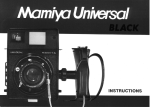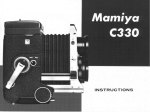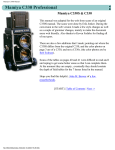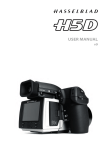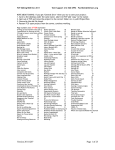Download Olympus 330 Digital Camera User Manual
Transcript
INSTRUCTIONS Viewfinder indicators Flash indicator Autofocus frame Autofocus indicator Spot metering LCD panel/Mode button Mode button G. MACRO When using the mode button, each mode will be displayed on the LCD panel. However, spot metering will be displayed in the viewfinder. LCD panel indicators SPOT SELF REMOTE B. Selftimer/remote control (p. 31) G. Macro (p. 29) C. Single-frame advance E. Auto zoom (p. 40) C. Continuous - frame advance (p. 48) E. Infinity mode (p. 43) E. Servo AF (p. 44) Battery remaining indicator C. DRIVE D. E. F. + / — SUBJECT FLASH C. Double exposure (p. 50) F. Auto flash (p. 21) F. Auto-S flash (p. 23) F. Flash OFF (p. 35) F. Fill-in Hash (p. 36) F. Slow-synchro fill-in flash (p. 38) D. Exposure compensation (p. 46) Exposure counter —1— Description of controls (1) Macro button Power switch LCD panel Shutter release button Selftimer remote control button Zoom buttons Viewfinder window Spot metering button Grip / shoulder strap Flash reflector Autofocus windows AF illuminator Back cover release —2— Description of controls (2) Mode cover Viewfinder Film window Rewind button Battery cover Tripod socket Functions listed below will not be cancelled when the power switch has been turned OFF. —Auto-S flash mode —The first frame in double exposure mode Drive mode button Flash mode button Exposure compensation mode button Subject mode button —3— Table of contents Description of controls ........................... 2 Before you begin................................... 6 Fill-in flash........................................... 36 Slow-synchro fill-in flash......................... 38 Loading the batteries.............................. 6 How to take pictures............................. 15 Auto zoom mode.................................... 40 Infinity mode......................................... 43 Servo AF mode ...................................... 44 Special effects . . . . . . . . . . . . . . . . . . . . . . . . . . . . . . . . . . . . . . . . 46 Exposure compensation............................ 46 Continuous mode.................................... 48 Double exposure mode ............................ 50 Auto flash photography......................... 21 Auto-S flash photography...................... 23 Camera functions and controls................ 25 Focus lock.......................................... 25 Spot metering...................................... 27 Macro photography.............................. 29 Selftimer/Remote control ...................... 31 Flash OFF.......................................... 35 How to use the soft case . . . . . . . . . . . . . . . . . . . . . . . . . . 52 Troubleshooting...................................... 53 To take better photographs........................ 55 Zoom lens............................................. 55 Autofocus (AF) ...................................... 57 Exposure............................................... 59 Care and storage..................................... 62 Specifications......................................... 63 Attaching the strap ................................ 8 Holding the camera ............................... 9 Loading the film.................................. 10 Unloading the film............................... 13 Simple point & shoot photography............. 15 —4— Thank you for purchasing the OLYMPUS Infinity Super Zoom 330. Please read this instruction manual carefully before using the camera. We also recommend that you shoot at least one roll of film just to familiarize yourself with the camera's features. Symbols used in this manual Correct Incorrect operation Order of operation Attention Press lightly Lamp on Lamp blinking —5— Automatic operation Before you begin... Loading the batteries Be sure power switch is OFF. Remove battery cover on the side of the grip. Insert two 3V lithium batteries as shown and replace cover. Use Panasonic CR 123A, Duracell DL 123A, or equivalent. WARNING: Do not mix different types of batteries or new and old batteries at the same time. —6— Switch power ON and check battery power level on the LCD panel. NOTE: LCD panel display switches off automatically after 90 seconds if no controls are used. When is displayed, batteries are OK. If flashes, batteries are low, have spares handy. If is displayed continuously, batteries should be replaced immediately. Remove batteries if you do not plan to use the camera for an extended period of time. —7— Attaching the strap —8— Holding the camera Hold the camera correctly. Keep fingers and camera strap away from the lens, viewfinder and flash reflector. NOTE: It is particularly important to hold the camera steady when shooting at longer focal lengths (telephoto); use both hands for maximum stability. —9— Loading the film This camera is designed to use DX-coded 35mm film. DX coding is used by virtually all major film manufacturers. DX coding allows the camera to identify and set the film speed automatically. If DX-coded film is unavailable, use ISO 100 film. *Open the back cover by sliding the back cover release toward the top of the camera. NOTE: Avoid direct light when loading the film. — 10 — Insert the film cartridge. Do not touch the lens with your finger or the film leader when loading. Align the film leader with the film loading indicator. — 11 — —If film is improperly loaded, the LCD panel will display a blinking "E". In this case, open the back cover, and realign the film leader. NOTE: Auto-S will be displayed if the camera was in Auto-S mode prior to being switched OFF. In all other flash mode, the camera reverts to AUTO when it is switched OFF. (For details on Auto and Auto-S flash mode, see pgs. 21 or 23) * Close the back cover. —The film will advance automatically and the exposure counter on the LCD panel will display the number "1" indicating the first picture on the roll. —The LCD panel will also display an "S"—to indicate single frame advance and either "AUTO or "AUTO S"—to indicate flash mode. Either flash mode may be used for point-and-shoot photography. —Use the window in the camera back to check type of film loaded. — 12 — Unloading the film * The camera automatically rewinds the film when you reach the end of the roll. NOTE: If you want to rewind the film before the end of the roll, press the rewind button with the tip of a ballpoint pen. Do not use any device with a sharp tip. The final reading of exposure counter before rewinding may be more than the number of —The exposure counter on the LCD panel exposure specified for the film. counts down as the film is rewinding. — 13 — *Open the back cover, and remove the —Once the film has been rewound, a blinking film cartridge from the camera. "E" will be displayed on the LCD panel. Further operations are not possible until the rewound film cartridge is removed. — 14 — Simple point & shoot photography How to take pictures * Remove lens cap. To remove the lens cap, press part A. *Set power switch ON. Switch power OFF, when removing lens cap. — 15 — *Adjust viewfinder. A dioptric correction ring on the view- *While looking through the viewfinder, aim the camera at the subject. finder eyepiece allows photographers who wear eyeglasses to adjust the focus of the viewfinder. Adjustable range is — 2 to +1 diopters. *Use the zoom button to adjust the size of your subject in the frame. (telephoto or wide angle) — 16 — —Press the "T" (Telephoto) on the zoom —Press the "W" (Wide-angle) on the zoom button to zoom in. (The maximum focal length in the "T" position is 105mm.) button to zoom out. (The minimum focal length in the "W" position is 38mm.) — 17 — *Position your subject within the autofocus frame in the center of the viewfinder. —When correct focus has been achieved, the "AF" light will appear in the viewfinder. —If the "AF" light is blinking, correct focus was not achieved. If this occurs, let go of the shutter release button. Make sure your subject is within the autofocus frame in the center of the viewfinder and press the shutter release button half-way again. *Press the shutter release button half-way to focus. — 18 — *When correct focus has been achieved (the "AF" light has appeared), press the * Switch power OFF when camera is not in use. shutter release button fully. As soon as the shutter is released, film will automatically advance to the next frame. — 19 — When shooting in extremely dim light, the AF illuminator on the front of the camera will emit a beam of infrared light to measure the distance to the subject. The AF illuminator has a range of approximately 4 m (13.1 ft). The autofocus system is designed to handle subjects that are among of below chart. If the subjects are out of this shooting range, the "AF" light in the viewfinder will blink, and the shutter Shooting Range will not release. However, the shutter may sometimes be released erroneously when the subject is extremely close to the camera. — 20 — Auto flash photography Confirm flash charge by pressing the shutter release button half-way. Compose your shot and press the shutter release button. The flash will fire automatically. —The light will appear in the viewfinder when the flash is charged. NOTE: In Auto and Auto-S flash mode, the amount of light emitted by the flash is automatically adjusted according to the Flash range: ( ) are for continuous shooting. ISO WIDE TELE 0.8 m — 4.7 (4.3) m, 1.3 m— 3.5 (3.2) m, 100 2.6 ft— 15.4 (14.1) ft 4.3 ft— 11.5 (10.5) ft 0.8 m— 9.4 (8.6) m, 1.3 m — 7.0 (6.4) m, 400 2.6 ft — 30.8 (28.2) ft 4.3 ft— 23.0 (21) ft — 21 — distance between the subject and camera. NOTE: The flash may not fire if the shutter is released while the flash is still charging. It takes about 3.5 seconds after the film is advanced to recharge the flash. — 22 — Auto-S flash photography Auto-S flash significantly reduces "red-eye" phenomenon (when a subject's eyes appear red) in flash portraits and group photos. Red-eye phenomenon is most likely to occur in very low light, and at longer focal lengths (telephoto). Auto-S flash can also be set in the standard operating mode. —"AUTO-S" will be displayed on the LCD panel. * Activate Auto-S mode by pressing the FLASH mode button located under the mode cover. — 23 — Flash Auto-S mode shooting range WIDE TELE ISO 0.8 m— 4.1 (3.8) m, 1.3 m— 3.1 (2.8) m, 100 2.6ft — 13.5 (12.5) ft 4.3 ft — 10.2 (9.2) ft 0.8 m — 8.2 (7.6) m, 1.3 m — 6.2 (5.6) m, 400 2.6 ft— 26.9 (24.9) ft 4.3 ft— 20.3 (18.4) ft * Compose your shot and press the shutter release button.—the flash will emit a rapid series of pre-flashes, followed directly by the main flash. *Hold the camera firmly while pressing the shutter release button. *To cancel Auto-S mode, press the Flash mode button located under the mode cover. NOTE: Auto-S mode will not be cancelled when power is switched OFF. — 24 — Camera functions and controls Focus lock Use focus lock when you want to position your subject outside the autofocus frame located in the center of the viewfinder. *Position your subject in the autofocus frame and press the shutter release button half-way. *While keeping the shutter release button pressed half-way, change the position of your subject in the viewfinder to achieve the desired composition. —When correct focus has been achieved, the "AF" light will appear in the viewfinder. — 25 — * Press the shutter release button fully to take the picture. NOTE: When focus is locked, exposure settings are also locked (AE lock). — 26 — Spot metering Use spot metering when you want to limit light metering to a particular area of the composition. It is particularly useful when lighting is uneven, or when there is strong backlight or sidelight. *Position the subject for spot metering within the autofocus frame in the center of the viewfinder. * Press the spot button. (green) will appear in the viewfinder, and the automatic spot metering exposure will be locked. — 27 — *Press the shutter release button half-way to focus. * Press the shutter release button fully to take the picture. NOTE: It is not necessary to continue pressing the spot button while the shutter release button is pressed half-way. — 28 — Macro photography Use macro mode to take pictures at extremely close range. (0.8 ~ *Press Macro button. , 2.6 ft ~ infinity) —The lens will automatically extend to telephoto and will be displayed on the LCD panel. NOTE: Zooming is not possible in Macro mode. — 29 — *Press the shutter release button half-way to focus. *To cancel macro mode, press the macro button again or switch the camera OFF. *If the distance between the subject and the camera is less than 1.3 m (4.3 ft) the viewfinder image will automatically shift to correct for parallax. At distances greater than 1.3 m (4.3 ft) the lens will function as a normal 105 mm lens; at distances less than 0.8 meters, the AF light in the viewfinder will blink and the shutter will not release. Shooting Range: Macro photography is possible when the subject is at a distance of 0.8 m (2.6 ft) to infinity ( ). If the distance between the subject and the camera is less than 1.3 m (4.3 ft), and when autofocus shooting is difficult (see page 57), press the shutter release button half-way to confirm focus. The camera will automatically correct for parallax. Then press the shutter release button fully. — 30 — Selftimer/Remote control (Optional) Selftimer photography *Set the camera firmly in position. *Press the /REMOTE (Selftimer/ Remote control) button until *Press the shutter release button half-way to focus. is displayed on the LCD panel. —When correct focus has been achieved, the "AF" light will appear in the viewfinder. — 31 — *Press the shutter release button fully to start the Selftimer. The shutter will be released 12 seconds later. *To cancel the Selftimer, press the /REMOTE button or switch the camera OFF. —The red AF illuminator on the front of the camera will light up for the first 10 seconds, then blink rapidly for 2 seconds until the NOTE: To prevent light from entering the viewfinder when setting the focus and exposure, do not remove your eye from the viewfinder until the Selftimer has shutter is released. been activated. — 32 — Remote control (Optional) shooting *Press the /REMOTE (Selftimer/ Remote control) button until is displayed on the LCD panel. *While looking through the viewfinder, aim the camera at the subject. *With the remote control lens cap unit in your hand, position yourself in front of the camera and press the release button on the unit's side. — 33 — —The red AF illuminator on the front of the camera will blink rapidly until the shutter is released. NOTE: Remote control operation may not be possible in strong backlight. Although all operating modes can be used in conjunction with the remote control unit, continuous-frame advance is limited to two frames. The battery included in the remote control unit is not possible to replace. However the battery life is approx five years. Remote control operation may be influenced erroneously by the backlight- ing through viewfinder. —The remote control unit functions at distance up to 5 m (16.4 ft) from the camera within a arc of about 30° (3.5 m (11.5 ft) to the right or left of the center of the frame). —The remote control can be set to release the shutter either 1 or 3 seconds after the release button is pressed. —About 90 seconds after the remote control mode has been activated, the remote control indicator on the LCD panel will begin to blink. If no remote control photographs are taken within 15 minutes, remote control mode will be cancelled automatically. To cancel remote control mode, press the /remote button, or switch the camera OFF. — 34 — Flash OFF This mode is to be used in situations where a flash is prohibited (as in a museum) or when not desired (for special effect). Press the shutter release button half-way to focus. Press the shutter release button fully to take the picture. To cancel flash OFF mode, press the FLASH button, or switch the camera OFF. *Activate Flash OFF mode by pressing the FLASH button located under the mode cover. —"OFF" will be displayed on the LCD panel. NOTE: The necessary shutter speed may be very slow (up to 2 seconds) to attain proper exposure. To prevent blurred pictures resulting from camera shake, the camera should be set firmly in position (with a tripod for example). — 35 — Fill-in Flash In this mode, the flash always fires regardless of available light. Use this mode for daylight shooting with backlit conditions to compensate for backlighting which may make the subject appear too dark. * Activate Flash fill-in mode by pressing the FLASH button located under the mode cover. *Press the shutter release button half-way to focus. —"FILL-IN" will be displayed on the LCD panel. — 36 — *Press the shutter release button fully to take the picture. *To cancel Fill-in flash mode, press the FLASH button again, or switch the camera OFF. — 37 — Slow-synchro fill-in flash Use slow-synchro fill-in flash to capture dimly lit backgrounds, such as the sky at dusk, while properly lighting the foreground with flash. * Activate slow-synchro fill-in flash mode by pressing the FLASH button located NOTE: The shutter speed may be very slow (up to 2 seconds) to attain proper exposure. To prevent blurring, the camera should under the mode cover until "SLOW" is displayed on the LCD panel. be set firmly in position (with a tripod for example). — 38 — * Press the shutter release button half-way to focus. * Press the shutter release button fully to take the picture. *To cancel slow-synchro fill-in mode, press the FLASH button, or turn the camera OFF. — 39 — Auto zoom mode Use Auto zoom mode to maintain a constant subject size within the frame, even though the distance to the subject may vary. —For head-and-shoulders portraits, appear on the LCD panel. *Activate the auto zoom by pressing the SUBJECT button located under the mode cover. Choose either head-andshoulders portrait or full-length portrait. —For full-length portraits, LCD panel. will will appear on the Zooming is not possible in Auto zoom mode. — 40 — *Position your subject in the center of the viewfinder and press the shutter release button half-way. —The zoom will operate automatically to attain the desired shot (head-and-shoulders or full-length). *Press the shutter release button fully to take the picture. * To cancel Auto zoom mode, press the SUBJECT button again, or switch the camera OFF. — 41 — Shooting Range NOTE: Outside the designated shooting range, constant subject size cannot be maintained. — 42 — Infinity mode—for distant subjects Use Infinity mode to photograph extremely distant subjects. Activate Infinity mode by pressing the SUBJECT button located under the mode cover until is displayed on the LCD panel. Press the shutter release button fully to take the picture. To cancel Infinity mode, press the SUBJECT button again, or switch the camera OFF. —When using infinity mode, the "AF" light will not appear in the viewfinder because the camera is already focused for distant subjects. — 43 — Servo AF mode—for moving subjects Use Servo AF mode to maintain constant focus on a moving subject. Activate Servo AF mode by pressing the SUBJECT button located under the mode cover until "SERVO AF" is displayed on the LCD panel. Press the shutter release button half-way to focus. —The focus will adjust at one-second intervals as long as you continue to press half-way on the shutter release button. —If you remove your finger from the shutter release button after pressing half-way to focus, the focus will remain locked until the shutter is released or Servo AF is cancelled. — 44 — To cancel Servo AF mode, press the SUBJECT button again, or switch the camera OFF. Press the shutter release button fully to take the picture. — 45 — Special effects Exposure compensation Use Exposure compensation to manually adjust the level of exposure to compensate for overall brightness or darkness, and to create special effects. —The compensation rate is adjusted at 0.5 EV increments to + / - 1.5 EV. *Adjust exposure compensation by pressing the + / - button located under the mode cover. *To cancel Exposure compensation mode, press the + / - button again, or switch the camera OFF. — 46 — -1.5 EV ±0 EV + 1.5 EV — 47 — Continuous mode Use Continuous mode to shoot a continuous series of pictures at 1.3 frames per second. (One frame per 3.5 seconds with flash; for details see pg. 21) *Activate continuous mode by pressing the DRIVE button located under the mode cover until "C" is displayed on the LCD panel. * Press the shutter release button half-way to focus. — 48 — NOTE: The focus and exposure will remain locked after the first frame regardless of any change in distance between the camera and subject. * Press the shutter release button fully to take the picture. *While the shutter release button is fully pressed, the shutter will continuously release at a rate of 1.3 frames per second. *To cancel Continuous mode, press the DRIVE button again, or switch the camera OFF. — 49 — Double exposure mode Use Double exposure mode to combine two images on a single frame. *Activate double exposure mode by pressing the DRIVE button located under the mode cover until "DOUBLE EXP" is displayed on the LCD panel. *Press the shutter release button half-way to focus. *Press the shutter release button fully. *The film will not advance after the shutter is released the first time. —The "DOUBLE EXP" display will blink. — 50 — *Press the shutter release button half-way to focus the second exposure. —When the shutter release button is fully pressed a second time, the double exposure is complete. The film advances and DOUBLE EXP mode is cancelled. *Press the shutter release button fully to take the picture. *To cancel Double exposure mode, press the DRIVE button again, or turn the camera OFF. —Turning the camera OFF will not cancel the DOUBLE EXP mode if the first frame has been exposed. — 51 — How to use the soft case Shoulder strap attachment ring *The shoulder strap can be attached to the soft case. — 52 — Trouble shooting Battery power About 30 rolls (24-exposure, half with flash) can be taken. However, flash and Even though the AF Illuminator lights, the camera is still not focusing correctly. It is sometimes difficult to attain an accurate distance measurement of subjects zoom operations consume more battery power. that have a low reflection ratio such as The camera does not work Make sure the power switch is ON. If the power switch is between the ON and OFF position, the camera does not work. Check to make sure that the batteries are loaded and inserted correctly. If a completed roll of rewound film has not been removed, the camera will not work. The camera does not focus correctly When the subject moves too fast or is not positioned within the autofocus frame in the center of the viewfinder (refer p. 57), the camera may not focus properly. For fast moving subjects try the focus lock with Servo AF mode (refer p. 44). — 53 — navy blue or black. The shutter will not release. Press the shutter release button half-way and make sure the "AF" light appears in the viewfinder. Flash does not emit. Make sure the camera is on Flash mode. When continuous flash shooting, there is sometimes a delay in the time required to recharge the battery. Shoot after the flash indicator appears in the viewfinder. When flash shooting, peoples' eyes come out red. * Red-eye phenomenon is a common The camera does not work in extremely cold weather. *In low temperature conditions, batteries temporarily lose performance. Try to keep the camera warm. problem in flash photography. The phenomenon occurs because the retina behind the pupil of an eye reflects flash light. Shooting conditions such as brightness and darkness of surroundings also affect red-eye phenomenon. Intensity of red eye phenomenon will differ from person to person as it depends on dilation of the pupil. Generally, when the distance between the camera and the subject increases so does the occurence of red eyes. To reduce this phenomenon use Flash Auto-S mode (refer to p. 23). — 54 — Zoom Lens Zoom Lens The Infinity Super Zoom 330 is equipped with a 38 —105 mm zom lens. A zoom is a lens with a focal length that changes when part of the lens moves. In the case of the Infinity Super Zoom 330, any focal length between 38 mm and 105 mm can be selected. The user, without moving, can change the composition of the photograph by zooming in for a close-up or out for a wide angle shot. In this way, the Infinity Super Zoom 330 makes extremely flexible photography possible that's equivalent to a camera with a number of interchangeable lenses. In practice, zooming can add immense pleasure to photography. The zoom operation is performed using the zoom button on the top of the camera body. "W" stands for wide-angle and "T" for telephoto. When the "T" is pressed, the lens moves forward towards the maximum length of 105 mm. When the "W" is pressed, it moves back towards the widest angle of 38 mm. On the top of the zoom lens, there are 38, 50, 70, 105 and MACRO indications; use these as a guide when zooming. 38 mm: This is a wide-angle shot which means that the lens is shorter. With this setting, because the angle of view is wide and the depth of field is greatest, sharp photographs with clear perspective and contrast can be obtained. 50 mm: The image is almost the same as that seen with the naked eye. At 50 mm, you can take a great portrait of 2 people or other subjects that would not look natural in a wide angle shot. With this focal length, many photographs can be taken over a wide range of applications, from snapshots and portraits to landscapes. (1) 38 mm 59° (2) 70 mm — 55 — 34° (3) 105 mm 23° 85 mm or more: When the lens is set to the maximum focal length of 105 mm, magnification is approximately three times greater than at 38 mm and you will be able to obtain genuine telephoto photographs. In contrast to wide-angle shots, the perspective is narrow, and the depth of the field becomes more shallow. Because the depth of field is not so great, objects in front of or behind the subject being photographed will be out of focus; make use of this in composing your photographs. Try taking close-ups with the telephoto setting. The telephoto lens is especially useful for sports photography and taking photographs of animals without disturbing them. Telephoto can make snapshots and portraits more interesting by using its shallow depth of field. When taking telephoto shots, be sure to hold the camera securely so that it does not shake. *The three pictures ((1), (2) and (3)) on the left are examples taken with the photographer zooming while standing still and the pictures clearly illustrate the differences obtained with different settings. The three pictures on the right are examples of when the dimensions of the subject are not changed. From these examples, you can easily see the difference in the relation between the subject and the background. Angle of view: This is the shooting and viewing angle of the lens, you zoom to adjust the composition, in your photograph. When the angle of the view is greater (W), the wide angle view is seen. When the angle is narrower, you have shifted towards the telephoto (T). Depth of field: This is the range within which objects will be in focus. Outside this range, nearer to the camera or further from it, objects will be out of focus. The shorter the focal length of the lens and or the larger the "f" number, the greater the depth of field. (4) 38 mm (5) 70 mm (6) 105 mm — 56 — Autofocus (AF) The Autofocus (AF) mechanism automatically adjusts focus. With it, the camera measures the distance to a subject and adjusts the lens so that the subject is in focus. In the Infinity Super Zoom 330, focusing is done by a newly - developed "Phase-Difference" detection system. In this system, light from the subject is picked up by a special sensor and any inconsistencies (phase differences) in the image are used by a microprocessor chip to calculate the best focus setting. Since the lens used in the Infinity Super Zoom 330 is very accurate, correct focusing is even more accurate and accomplished by just aiming the lens at the subject. When there is no light reflected from the subject, for example in a dark room, focusing is performed using a beam of light from the camera (the AF-Illuminator). Autofocus is designed so that the object in the center of the picture frame is correctly focused. However, sometimes you may want a subject that is not in the center of the frame to be in focus; for such cases, the Infinity Super Zoom 330 is also equipped with a focus lock mechanism. For example, when your subject is at the edge of the picture frame, not in the center, first move the camera slightly so that the subject is in the center of the autofocus frame, then press the shutter release button halfway to focus. While keeping the button pressed, recompose the picture, and press the button fully. (See "Taking Photographs II" on p. 33). By doing this, photographs with any required composition can be taken. In addition, at the time the focus is locked, the exposure is also determined automatically and locked (AE lock). (1) Subject that does not include (2) Subject with low contrast (3) A rapidly moving subject horizontal lines — 57 — Although the Infinity Super Zoom 330 can focus in almost any situation, there are certain conditions, such as those illustrated below (on the left), in which it may not be possible to obtain the correct focus. The AF in the viewfinder will usually blink to warn you during these conditions; however, in situations (4), (5) and (6), the green AF in the viewfinder may light even though the lens is incorrectly focused. In any of these situations, you can try focusing on a subject at a similar distance and then, using the focus lock. (4) Two subjects within the focusing frame, at different (5) Excessively bright light in the center of the focusing frame distances — 58 — (6) A subject with a repeated pattern Exposure Programmed exposure One of the basics of photography is exposure. Exposure refers to the amount of the light which strikes the film. The correct amount of the light, or correct exposure is controlled according to the film speed (indicated on the film package, such as ISO 100 or ISO 200), the shutter speed and aperture. Many cameras are now equipped with a programmed exposure function so that the correct exposure can be obtained easily without any guess-work or previous photography experience. With programmed auto exposure, the camera automatically sets the most suitable combination of "f" stop and shutter speed for subjects at any brightness level. As a result, the correct exposure will be obtained almost immediately. It's an automatic exposure system that means you'll never miss the opportunity to take a photograph. All the photographer has to do when holding the camera is to concentrate on aiming it correctly and press the shutter release button. For example, when you change from a dark to bright subject, the camera adjusts itself to maintain the correct exposure. Anyone can take photographs without worrying about making a mistake. Program chart The chart shown here is a program chart when the focal length is 38 mm and 105 mm. When the subject is brighter than EV 11 for wide-angle shots and EV 12 for telephoto shots, the aperture and shutter speed change simultaneously. When the subject is darker, the aperture opens fully and the shutter speed changes. Naturally the program takes any zoom setting into consideration and sets the aperture and shutter speed which are most appropriate for every shot. So that camera shake is less of a problem, the shutter speed will not be slower than 1 740 sec. for wide-angle shots and 1/80 sec. for telephoto shots. When the subject is darker and requires a slower shutter speed, the flash fires automatically; in the slow-synchro fill-in or flash-off mode, stays open for as long as needed-up to a long 2 sec. automatically. (Broken line section) — 59 — Spot metering Among methods for measuring the amount of light, the most widely used is the "center - weighted average light metering system" (Fig. A). This system gives excellent results when taking ordinary shots; however, when there is an extremely bright or dark area in the frame, a center - weighted average light metering system may not automatically set the best exposure. When taking a portrait for example, if the background is too bright, the subject will be dark, and vice versa. The sophisticated light metering system used in the Infinity Super Zoom 330 which is used to obtain proper exposure in this situation is called "spot metering". Spot metering (Fig. B) measures and calculates the correct exposure only from the brightness in the central section of the frame. This makes spot metering very convenient when the subject is back lit, side lit, or spot lit. Even when the subject looks dark and does not To make white objects look very the (+) direction, to make black compensation button to the (-) stand out from the background, your photographs will be exposed properly. white, use spot metering and then operate exposure compensation button to objects look very black, use spot metering and then operate exposure direction. Double exposure "Double exposure" refers to a technique in which images are superimposed by releasing the shutter twice without advancing the film. In the case of the Infinity Super Zoom 330, you can easily take double exposures by pressing the DRIVE button inside the mode cover. By doing this, even when the shutter is released, the film won't advance to the next frame until the shutter has been released for the second exposure. Used together with the spot metering function, you can take extra special - effects photographs, with the same face but with different expressions appearing twice in the same photograph, for example. We recommend combined use of exposure compensation and the flash for applications of this type. — 60 — With the Infinity Super Zoom 330, the exposure can be compensated from -1.5 EV to +1.5 EV in 0.5 EV steps, by simply pressing the exposure compensation button marked + / - inside the mode cover. For instance, when shooting a back lit subject that's too far away for the flash to be effective, the exposure should be compensated to the positive side (more light) so the subject doesn't look too dark in the photograph. When the background is dark and details can't be seen and only the subject is bright, the exposure should be compensated to the negative side. (less light) — 61 — Care and storage *Do *Do *Do *Do not not not not expose the camera to extreme heat or strong magnetic fields. apply excessive force to the camera or its controls. rotate the camera once it is mounted on a tripod. touch the contact points inside the camera. *Do not use organic solvents, thinner or benzine to clean the camera. *Avoid high impact from bumping or dropping the camera. *Never disassemble the camera; it contains a high-voltage circuit. *Do not disassemble or expose batteries to excessive heat. *Do not expose the camera to rain shower and water. *Avoid sudden temperature change. *Do not put the camera in the extreme heat (over 40°C or 104°F) or in the extreme cold (below -10°C or 14°F). *In case of malfunction, consult your nearest Olympus dealer, or nearest Olympus service center. — 62 — Specifications Type: Full-automatic 35 mm autofocus lensshutter camera with built-in 38 —105 mm Zoom lens Film format: 35 mm standard DX coded film (24 x 36 mm) Lens: Olympus 38—105mm F4.5-6 lens with 12 elements in 11 groups Shutter: Programmed electronic shutter Viewfinder: Kepler type 0.46-1.2x bright frame zoom-finder (with autofocus frame, AF indicator, flash indicator, spot metering indicator) Parallax compensation system in macro photography Finder view-field: 85% of actual picture field Focusing: Passive autofocus system with focus lock Focusing range: 0.8 m (2.6 ft)— (infinity) (at 38 mm) 1.3 m (4.3 ft)— (a (at 105 mm) 0.8 m (2.6 ft)— (infinity) (at macro mode) Exposure control: Automatic exposure control with programmed electronic shutter (Center-weighted average light metering, switchable to spot metering) Auto exposure range: WIDE: EV3.4 (F4.5, 2 sec.) —EV17 (F16, 1/500 sec.) TELE: EV4.4 (F6, 2 sec.) —EV17 (F18.4, 1/400 sec.) Exposure compensation: ± 1.5EV Compensation possible (1/2 step) Exposure counter: Progressive type, displayed in LCD panel Selftimer: Electronic Selftimer with 12 sec. delay Film-speed range: Automatic setting with DX coded film ISO 25 — 3200 with color negative film (Actual setting at 25, 50, 100, 200, 400, 800, 1600, 3200. For other intermediate film speeds, the camera is automatically set to the lower speed. For ISO 32 film, it is set to ISO 100.) Film loading: Automatic loading (automatically advances to first frame when camera back is closed) — 63 — Film advance: Automatic film winding Film rewind: Automatic film rewind (automatic rewind activated at the end of film, automatic rewind stop), rewind possible at any point with rewind button. AF illuminator: Automatic actuation in low light Flash: Built-in flash Recycling time: SINGLE MODE: approx. 3.5 sec. (at normal temperature) Battery check: Displayed in LCD panel Power source: Two 3V lithium batteries (CR 123A/DL 123A) (replaceable) Dimensions: 137 (W) mm x 80 (H) mm x 99 (D) mm (5.4" x 3.1" x 3.9") (excluding protrusions) Weight: 610 g (21.5 oz) (without batteries) Flash working range: at Auto Mode, WIDE: 0.8 m (2.6 ft) —4.7 m (15.4 ft) TELE: 1.3 m (4.3 ft) —3.5 m (11.5 ft) with ISO 100 negative color film WIDE: 0.8 m (2.6 ft) —9.4 m (30.8 ft) TELE: 1.3 m (4.3 ft) —7.0 m (23.0 ft) with ISO 400 negative color film Flash modes: AUTO (automatic flash activation in low light and backlight), AUTO-S (Red-eye reducing, in low light and backlight) FILL-IN (forced activation), SLOW (slow-synchro possible with longest shutter speed of 2 sec.) OFF (activation stop) — 64 — OLYMPUS OPTICAL CO.,LTD. San-Ei Building. 22-2. Nlshl Shinjuku 1-chome, Shinjuku-ku. Tokyo. Japan Tel 03-340-2211 OLYMPUS CORPORATION Crossways Park. Woodbury. New York 11797, U.S.A. Tel. 516*364-3000 OLYMPUS OPTICAL CO. (EUROPA) GMBH Posttech 104908. Wenoenstrasse 14-16, 2 Hamburg 1. West Germany Tel: 040-23773-0 OLYMPUS OPTICAL CO.(U.K.)LTD. 2-B Honduras Street. London EC1Y OTX, England Tel. 01-253-2772 PRINTED IN JAPAN 1289. 9MM



































































